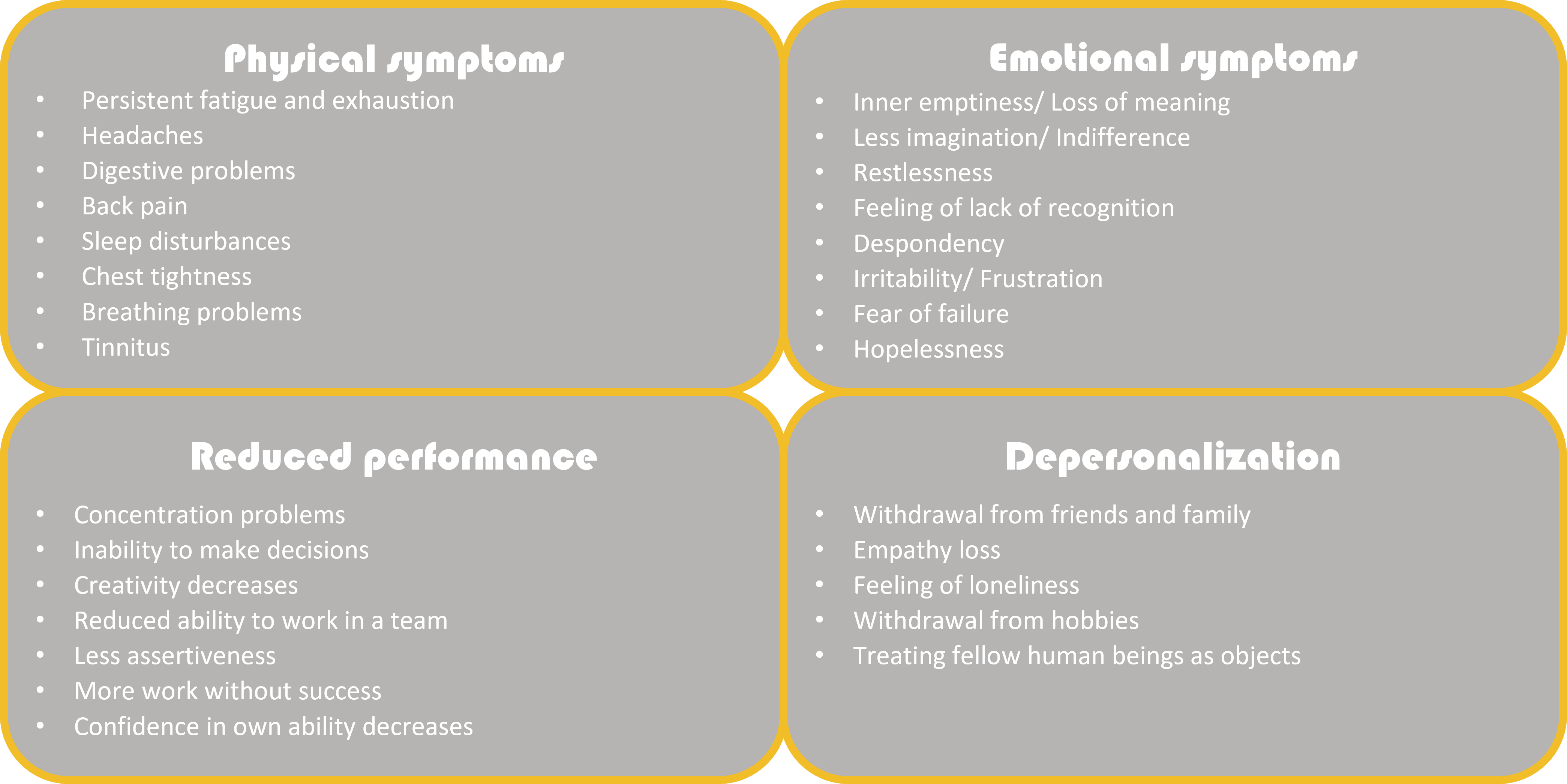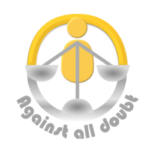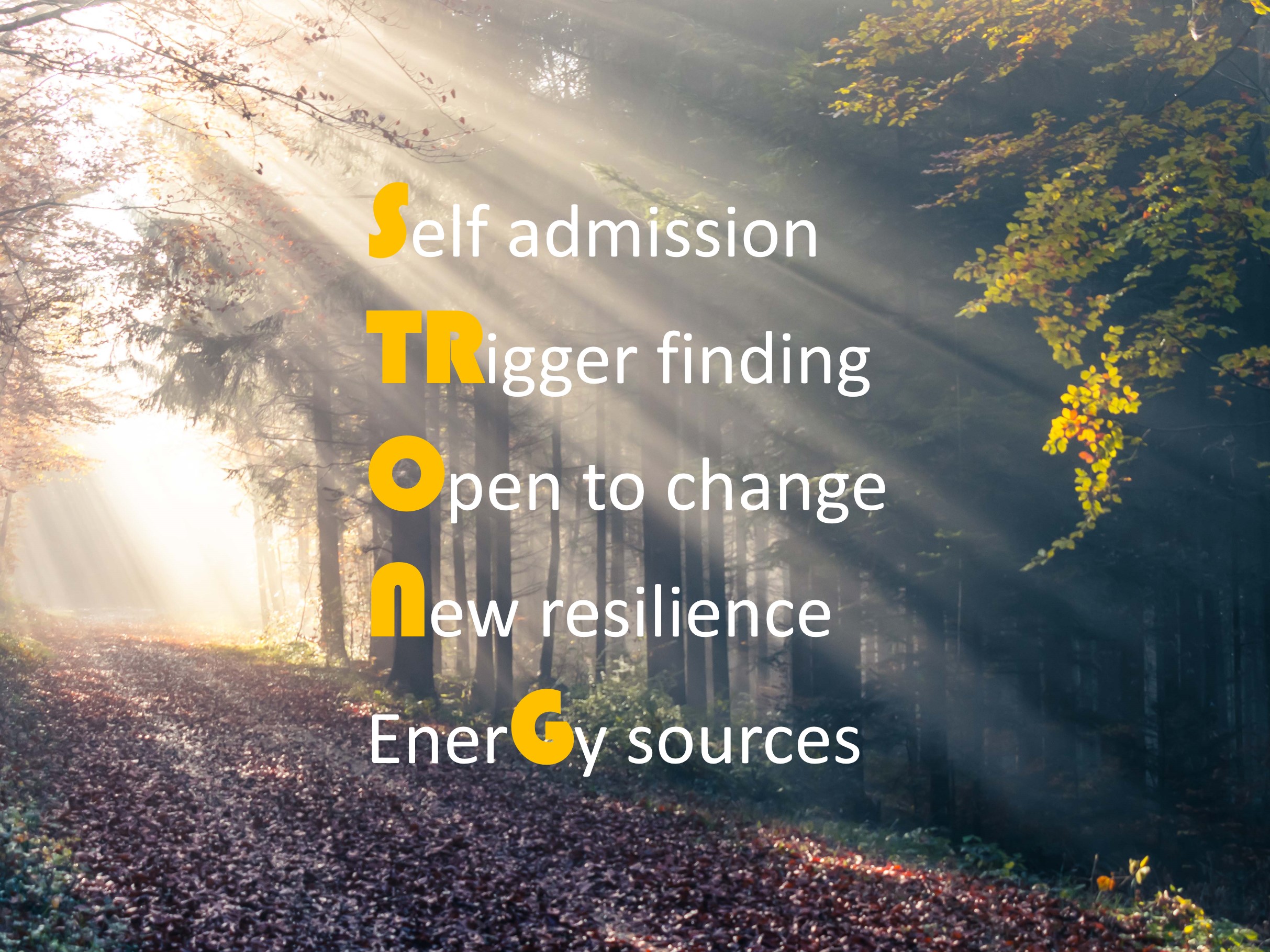Burn-out
Illness, symptom or imagination?
More and more people are affected, but what is behind burn-out? How do you recognize it and what can you do about it?
Chapter 1: Disease or not?
In May 2019, many newspapers ran headlines with “Burn-out recognized as a disease for the first time”. This is not quite correct. The WHO has assessed “occupational phenomenon” i.e. work-related burn-out in the new ICD-11 as a “factor affecting health status” and defined it in three dimensions. The first dimension is a feeling of dwindling energy and exhaustion, the second is an increasing mental distance to the job and negative attitude towards one’s own job. The last dimension is a significantly reduced ability to perform on the job. ICD-11 is scheduled to go into effect in January 2022.
The ICD is the “International Statistical Classification of Diseases and Related Health Problems,” which is used, for example, for billing health insurance companies.
In Germany, burn-out is already a recognized diagnosis. However, it is not a disease, but an additional or framework diagnosis. It is described as “problems related to difficulties in coping with life.”
Since burn-out is difficult to grasp and everyone has individual symptoms, there are also many definitions that make it difficult to classify it as a disease.
You can learn more in my article “Is burn-out a trend?”
Chapter 2: When does burn-out occur?
Burn-out is very individually influenced. Usually situational reasons and personal factors come together.
Often burn-out hits those people who have a high self-motivation and dedicate themselves with full commitment to a cause. They often motivate themselves by having the feeling that they are doing something worthwhile or improving unjust conditions. Another motivation can be to want to fulfill one’s own, too high, demands. These personal factors alone are usually manageable. But if a catalyst is added, this can mean the beginning of a burn-out. There are many catalysts, but I would like to name a few:
- Unfulfillable targets
- Strong competition in the company
- Personal upheaval (death of partner, job change, wedding)
- Lack of control and influence
- Conflicts in the workplace
- Financial pressure
- Lack of success
- Long-lasting high workload
- Time pressure
These situational reasons, combined with history and life situation can lead to burn-out.
You can find out more about the causes of burn-out and who can be affected by burnout in my articles.
Chapter 3: What are the symptoms of burn-out?
The symptoms and combination of symptoms are as diverse as we are as people. Find out if there is a difference between man and women. However, they can be divided into 4 groups.

Chapter 4: When does burn-out begin?
A burn-out is not just there. It is often a long way before burn-out is even recognized. For this purpose, e.g. Unger and Kleinschmidt or Freudenberger and North have depicted burn-out in phases on a spiral, which turns faster and faster towards the bottom. I use here spiral of exhaustion in three steps of Unger and Kleinschmidt.
Step 1: First signs of exhaustion
Many of us have already experienced this step. It is often initiated by pain of all kinds or a higher susceptibility to illness. Followed by sleep disturbance, and a thought carousel. Thoughts like: “I can’t change anything anyway!” are typical in this phase. A helplessness develops that leaves one with no way out.
Step 2: The exhaustion progresses
In this step, behavior changes, with the focus now being on working. Often one becomes more irritable than before and sometimes even reacts aggressively. The first concentration problems appear. It is difficult to remember the simplest things. Often you work more and more in this phase in order to achieve the desired success and get stuck in a topic. As a result, you withdraw because you simply don’t have the energy to do anything in your free time. In addition, there are feelings of guilt about not being able to do justice to friends and family.
Step 3: Exhaustion
In the last step, you are heading for complete exhaustion. At the beginning of this step, you are often led by thoughts such as “I can’t do this anyway!”, you make yourself small. This often leads to a loss of motivation or interest, because one no longer has confidence in oneself and becomes discouraged. This leads to strong mood swings and even suicidal thoughts. The end result is apathy and depression.
Chapter 5: What to do in case of burn-out?
In this chapter I would also like to refer to the three steps according to Unger and Kleinschmidt, even though the reversal of the spiral is very individual for everyone.
Step 1: First signs of exhaustion
Here you can still do a lot yourself. Find out what makes you so exhausted or restless. Think about what is behind it. Maybe it’s proverbs like “No pain, no gain” or personal attitudes like “I have to do everything perfectly!” Or do you simply lack the change between tension (stress) and relaxation. As a next step, you can plan small but concrete steps for change. For example, if you lack relaxation, consciously plan it into your daily routine. Just a few minutes of breathing or a short walk during your lunch break can help.
I would be happy to support you in this! Just contact me for a non-binding initial consultation.
Step 2: The exhaustion is progressing
In this step I recommend that you seek support. Your burn-out has already had time to progress and it is getting harder to reverse the spiral. You should now visit your family doctor. He can clarify whether your symptoms have physical causes or consequences and help you to alleviate or heal them. In addition, I recommend psychological counseling during this phase. It can support you in planning and taking the first steps towards change. You must now systematically set a new course.
I would be happy to support you in this! Just contact me for a non-binding initial consultation.
Step 3: The exhaustion
You have reached the highest step, now it is high time to seek professional support. Contact your family doctor and/or seek psychological help. You can no longer turn the exhaustion spiral around on your own. But together with help you can! Since your way up to here was already very long, the reversal unfortunately also takes longer and is also often supported with an inpatient treatment. There you will get help to change your behavior so that you don’t get into the same exhaustion spiral again.
If you need help finding support, feel free to contact me.
In general it can be said that it is always about changing your own behavior and that increases the pain at first. If you recognize it early, you can take countermeasures in time. Do not wait until stage 3, the complete exhaustion! To gain more insight read also 3 steps to overcome burnout.
Chapter 6: Burnout prevention
Last but not least, let’s look at what each individual, but also you as an employer, can do to avoid burnout.
As an employer, the most important thing you can do is create the conditions that make it possible to admit that there is a problem without condemning it. Also, you see signs such as increased sick days or irritability. Not only is it okay to address these issues, but it also encourages an open approach to the topic. You can show your employees the possible help and support them in accepting it.
But that’s only part of prevention. Everyone can acquire behaviors and insights that will make them more resilient against burnout. For this purpose I have developed the program “STRONG against Burnout“. With the STRONG formula you can protect yourself in the best possible way. This includes having clear goals and ideas, but also knowing your stressors and adjusting your behavior accordingly.
What others say about me
3 sides of the same coin: burnout prevention in the work context
3 sides of the same coin: burnout prevention in the work context The topic of burnout prevention is becoming increasingly important - companies, managers and employees alike are recognizing [...]
Mental stress in the workplace: action required!
Mental stress in the workplace: action required! A closer look at current studies and developments The reports of both the DAK and the TK show a clear increase [...]
Generation Z and Burnout
Generation Z and Burnout: How Employers Can Help The new generation of employees, known as Generation Z, are known for their strong drive to fight for their goals. This [...]
The generation burnout
The Burnout Generation: Why Generation Y is more at risk of burnout Generation Y - these are people who were born in the 1980s and are now between 30 and 40 [...]
Burnout prevention- A 5 Step plan
Burnout has become a widespread disease that affects more and more people. But you can not only act when you are already in a burnout, but also preventively. But how can burnout be [...]
Burnout prevention at work
The first step to burnout prevention at work is to talk about it! Yes, talking about such things at work can be unpleasant, but it is necessary. Photocredit: Verena Küppers Photography [...]
3 steps to overcome burnout
As different as the causes of burnout are, when it comes to helping with burnout, there are 3 steps to overcome burnout: 1. The most important: admit to yourself that you have a [...]
Does burnout progress differently for men and women?
As already mentioned, burnout progresses differently from person to person, but in the course or handling of it, one can often see the different imprints of men and women. For example, society's image [...]
What you always wanted to know about online Life Coaching
You will find what I experienced and how it made me the person I am now. Because in every challenge there is also something to learn about yourself. The biggest and ongoing learning is to be yourself- against all doubt from yourself and others.
Also, you get some free input about methods I use during the Life Coaching and how they worked for me. Not every method will work for you too, but I am sure together we can find something that works for you!
Read more of my learnings
There are many reasons why I chose to offer my services online.
Here are the three most important ones:
- In addition to all the daily tasks, I wanted to save you from having to drive to a life coach
- You should feel as comfortable as possible during our sessions.
- Professional and private travels should not get in the way of our conversations.
To these good reasons I now add Corona. In my work at the children’s and youth telephone it becomes clear to me again and again, that just now such an offer is very important.
In my point of view Life Coaching is all about your challenges in life. Whether to balance your life the way it is good for you, coping with stress or facing changes – these are all topics I am happy to support you with!















